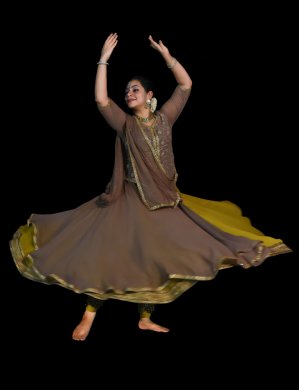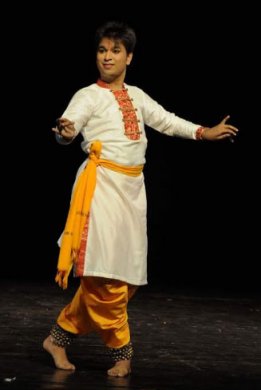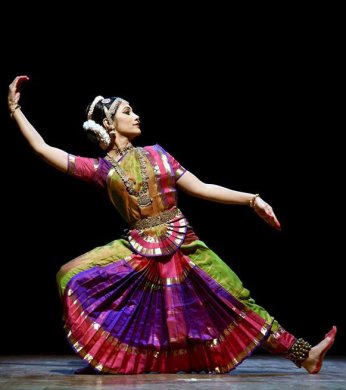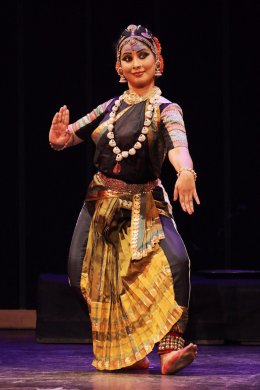
|   |

|   |
 e-mail: leelakaverivenkat@gmail.com Young dancers to the fore November 7, 2017 Ashok Vajpeyi under Raza Foundation has initiated a programme of providing young hitherto unknown dancers a chance to perform - a much needed thrust in an area where sponsors are not very willing to venture beyond established names. The program under the title of Uttaradhikar presented its first dancer Rupanshri Kashyap - a disciple of Guru Kumudini Lakhia - at the Stein auditorium, Delhi, and it was a welcome trend for the teacher to introduce her student saying that as one who had been grooming Kathak students for years, what she aspired for in her training was to inculcate the ability in a disciple to be her own dancer - rather than becoming a copy of the guru or for that matter any other artist. This could only happen when the student developed an inner understanding of the identity of the art form he or she was trying to learn.  Rupanshri Kashyap "You have all seen Sanjukta Sinha who is now well known. Rupanshri has her own style - different from Sanjukta's." Within moments of starting the recital, with her extremely graceful dipping and rising movement, the dancer proved the teacher's words. With her ability to play with tala patterns, and the freedom with which she adapted to the open nature of the Kathak concert format, one could sense that here was a dancer totally at ease with the tabla player and what he could confront her with as a challenge. In her tatkar, the tisra, chatusra, khanda, misra and sankeerna patterns flowed, with complete clarity in footwork. Whether rendering a chakradhar Paran with jumping steps, or weaving tight tihai-s or presenting the grace of gats, the dancer moved with effortless control. She has a style where in the midst of a lasya filled smoothness of rhythmic flow, a sudden stress and accenting at a point in the rhythmic cycle comes like a flashing, unexpected moment of awakening. The dancer's abhinaya too had its persuasive appeal. A bandish in Kalavati, "Maika piya bulave, Nananda mori bairan, Saasmori jhooti, Andheriya raat dar mora lage", one liked the absence of self-consciousness with which the dancer treated the lyric - wherein the lover beckons, the mother-in- law is seen as a liar and the sister-in-law is no friend! But all said and done, one would have preferred a less lightweight abhinaya lyric. The well rehearsed accompanists were all of a good standard.  Vishavdeep Under the same platform for promising artists, thanks to the generosity of the legendary painter Raza who left all his wealth for the betterment of art, yet another Kathak dancer, a male this time, Vishavdeep was presented at the IAS Officers' Institute auditorium, Delhi. A disciple of late Narayan of Jammu, and later Nandini Singh and now Prerana Shrimali - all dancers representing the Jaipur gharana - Vishavdeep, now one of the Kathak Kendra Repertory Group, is a fine combination of precision and grace. Rarely does one come across a male dancer from the Jaipur line, who moves with such supple line and perfection in the way the torso movements are executed, along with the lean straight body stance and chakkars of varying types executed with smoothness - both clockwise and anti-clockwise with double pirouettes undertaken in complete control over the stop on the sama. In the Jhaptal invocation to Shiva, the iconographic symbols of the deity, like the snake garland, Ganga perched atop the jatha, the trinetra, the damaru and each part was shown with dignity and precision, with the concluding chakkars to the chant of Om Namah Shivaya - all making an immediate impression about the young artist's quality. The nritta in teental began with upaj, the improvisations of footwork danced at speed. After this, the tempo instead of increasing had to be curtailed to suit the rendition of the other intra-forms. Ganesh Paran, a signature composition of the Jaipur gharana and thata in Jaipur school, which covers the stage with footwork were rendered with grace and the short gat sequence saw the Ched/Chad sentiment evoked through nritta. The omission for this critic was in the absence of any abhinaya item, for with Vishavdeep's kind of approach to the dance, one would have thought that it was tailor-made for interpretative dance. Yet another young talent, at the IIC auditorium, but outside the Raza Foundation umbrella, was Bharatanatyam dancer Kirti Ramgopal from Bangalore - a disciple of Padmini Ramachandran, and now Priya Govind and Bragha Bessell in Chennai. Following a brief homage to Ganesha in Hamsadhwani followed by Misra Alaripu rendered to taped music in Shanmukhapriya, the centrepiece of the recital in raga Hindolam was based on verses from the Krishnakarnamrita, "Vadane navaneeta gandha" the dance composition of Jhanavi Jaiprakash revelling in a description of the varied aspects of Krishna's eyes, his walk, his talk, his smile, his dance and his flute music. The charming butter thief's sparkling eyes become tearful when chastised by mother Yashoda. The same eyes are suffused in compassion at the call of the devotee like Draupadi, as he springs to her rescue. The teaser of the gopis, after breaking their pots of buttermilk, pleads innocence saying that a bird pecked at the pot creating a hole. Heroic Krishna who overpowers the snake Kaliya is also the sringar swain of Radha. The final charanam line "Kadamba mule kridatam venu gayantam achhutam" describes Krishna as the mesmeriser with his flute music.  Kirti Ramgopal Kirti Ramgopal's Bharatanatyam has clean lines and she has an animated face for abhinaya. The all Krishna recital also saw the interpretation of an abhang in Misra Yaman, the interpretation of which had guidance from both Priya Govind and Bragha Bessell, "Rusali Radha Rusala Madhav Rusale Gokul sare." The whole of Nature in Gokul reacts to a sullen Radha who in turn makes Krishna feel the same. As for Nature the joyous creeper droops, insects and butterflies seeking nectar from the flowers stay away and the peacock no longer unfurls its plumes to dance - all affected by the mood of Radha/Krishna. The Tillana in Brindavani, a Balamurali composition also ended with homage to Krishna. While one was treated to a very pleasant dancer in a suite of items chosen with a variety of moods flashing one after the other, to know the abhinaya depths one would like to see a more serious Padam, and a classic Sringar Varnam rendered by the dancer. The recorded music had Nandakumar Unnikrishnan as singer and in the abhang it was Preeti Mahesh's voice.  Ayana Mukherjee (Photo: Inni Singh) Meanwhile Vanashree Rao, the Kuchipudi artist, presented one of her students Ayana Mukherjee at Habitat's Stein auditorium. Initially trained under Vempati Chinna Satyam and later both Guru Rama Rao and Vanashree, before as a member of Rasa United coming largely under Vanashree's baton, Ayana has stage presence buttressed by good Kuchipudi technique. She began with Mahadeva Shiva Shambho and while this is a much rendered composition, Vanashree's choreography brought out certain phrases describing Shiva in the lyric like being decorated by a snake garland, of having the entire cosmos as his body, of being endowed with the beauty of countless Manmathas, and being the Protector of multitudes, through vivid dance imagery and her composition of teermanams showed unique arithmetical tightness with an onomatopoeic vocabulary of rhythmic syllables. Ayana rendered the item visualising the god described in all his grandeur, without diluting the general mood of the devotee in which she is paying homage to him. The next abhinaya item (a legacy from late Nataraja Ramakrishna to Vanashree), a Kshetrayya Padam "Evvade vaadoo" in raga Mohanam, is the query of a praudha nayika who in a mixture of curiosity and wonder asks as to who that man is who was looking at her with such tenderness and love. He stood under the Parijatam and embraced her from the back and when she demurred, said that Manmatha had made him behave thus! Was that Parthasarathy himself? Now only signs of his presence remain. But where is he? Ayana, while charming with her very eloquent eyes, needed to catch more of the praudha sensitivity and also the curiosity in wanting to know who that romantic man was - now nowhere to be seen. The Pravesha Daru from Bhama Kalapam in Bhairavi was performed with Úlan by the dancer, the choreography being the work of Vempati Chinna Satyam. She caught the vanity of Satyabhama as also the pangs of separation from her husband Krishna very well. Yet another of Vanashree's compositions making full use of the theatrical nature of the Kuchipudi tradition, was an Ekapatra Abhinaya based on an episode from the Mahabharata, which opens with Bhishma lying mortally wounded on his bed of arrows, prior to his death. A throw-back paints the picture of Krishna being sent as messenger by Yudhishtira to Dridharashtra to entreat upon the Kauravas that a part of the kingdom be returned to the Pandavas who had returned from their period in exile. A furious Duryodhana refuses to part with even an inch of land and mocks at Krishna whom he threatens to imprison. Krishna reveals his cosmic identity. While passing from one role to another, the dancer did her bit, the ragamalika score compiled by Vasudevan and Venkatesh in ragas like Revati, Arabhi, Durga and Jog fully aiding the natya oriented composition, though with Vasudevan intervening in places and Keshavan's mridangam and Rohit Prasanna on flute with Annadorai on violin and with Venkatesh singing and nattuvangam by Vanashree, all the participating elements of a standard, there was need to be in perfect sruti alignment - which fell short in places. The concluding number was again not common to the Kuchipudi format being based on Veena Sahasrabuddhe's Maha Kali composition in Misra Malhar. The elegant black (at back) and white (in front) costume of the dancer designed by Vanashree was elegant and the skull garland completed the outfit. The Kali, Kapalini, Mata, power and ferocity concluded on a note of total quietude with the prayer to Dharma-sankata-dharini. Ayana shows good promise. There are young dancers showing that they have the talent to make it big. One only hopes that they find the right breaks!  Writing on the dance scene for the last forty years, Leela Venkataraman's incisive comments on performances of all dance forms, participation in dance discussions both in India and abroad, and as a regular contributor to Hindu Friday Review, journals like Sruti and Nartanam, makes her voice respected for its balanced critiquing. She is the author of several books like Indian Classical dance: Tradition in Transition, Classical Dance in India and Indian Classical dance: The Renaissance and Beyond. Post your comments Please provide your name and email id when you use the Anonymous profile in the blog to post a comment. All appropriate comments posted with name & email id in the blog will also be featured in the site. |